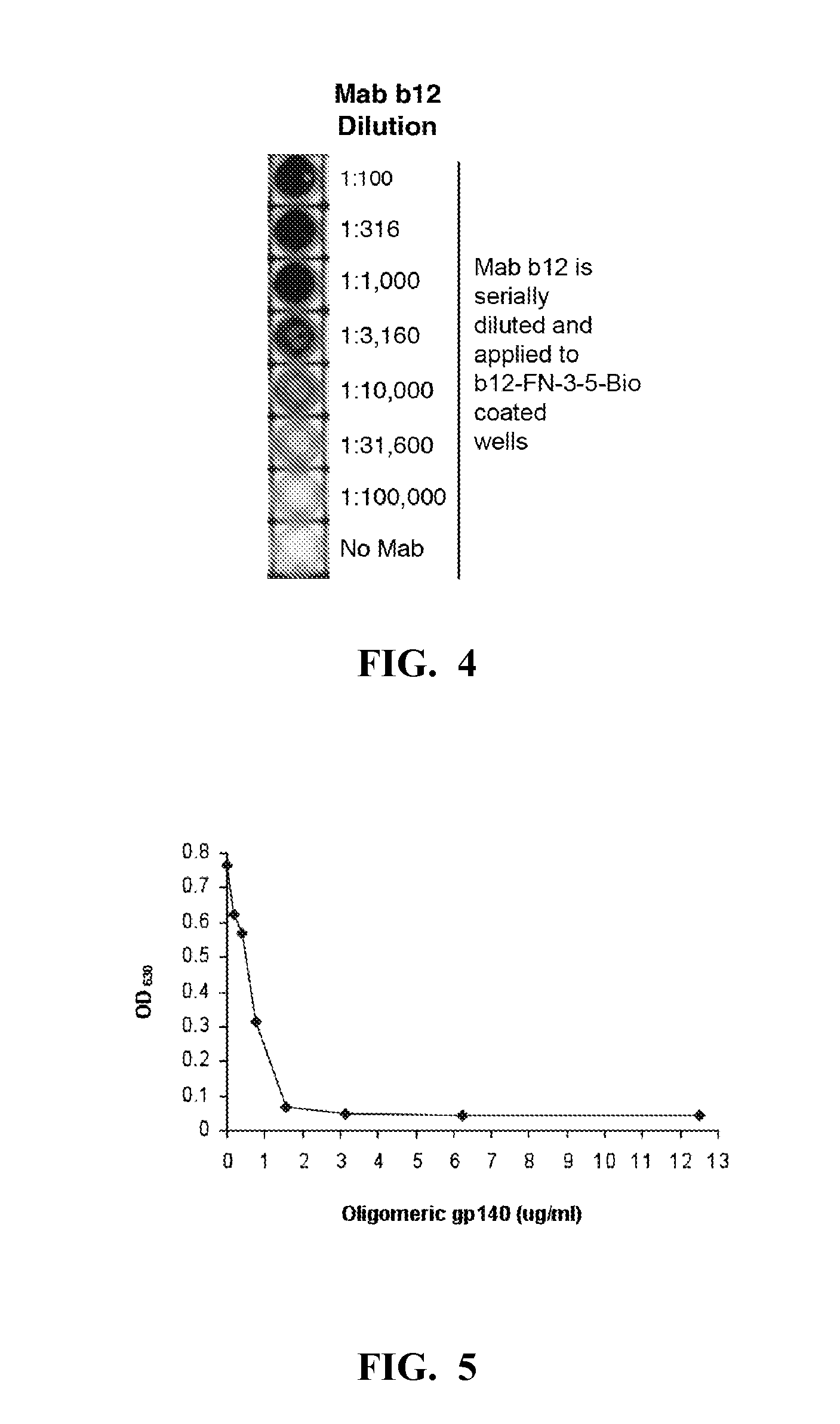Antigenic mimics of discontinuous epitopes of pathogen recognized by broadly neutralizing antibodies
a technology of broadly neutralizing antibodies and antigen mimics, which is applied in the field of polypeptides, can solve the problems of inability to elicit broadly neutralizing antibodies (bna) that recognize the hiv-1 envelope, approaches have yet to elicit the desired antibody response, and immunogens have not been developed
- Summary
- Abstract
- Description
- Claims
- Application Information
AI Technical Summary
Benefits of technology
Problems solved by technology
Method used
Image
Examples
example 1
Generation of FNfn10, Two-Loop Display Library
[0204]A FNfn10 scaffold was cloned into pAP-III6FL vector (a derivative of pAP-III6 containing a full-length gene III from bacteriophage M13) downstream of a Flag epitope sequence. The resulting plasmid was introduced into CJ236 E. coli host cells and single-stranded DNA template containing uracil was produced by infection with VCS M13 helper phage. Single-stranded phage DNA was purified and annealed to mutagenic oligonucleotides as described by Tonikian et al., “Identifying Specificity Profiles for Peptide Recognition Modules from Phage-Displayed Peptide Libraries,”Nat. Protoc. 2(6):1368-86 (2007), which is hereby incorporated by reference in its entirety. The entire annealed and extended template mix was purified on a PCR clean-up resin (Sigma) and electroporated into TG1 cells (Stratagene). Ampicillin resistant transformants were suspended in LB medium, diluted to ˜5×107 cells / ml and grown at 37° C. for two hours. Ten ml of the cultur...
example 2
Library Selection Against MAb b12
[0208]The b12 Mab was immobilized in two microtiter dish wells at 50 μg / ml in TBS and after blocking with casein; 50 μl of the combined library was added to each well (˜5×1011 total phage) and the plate was shaken for 2 hours at room temp. The phage were then removed and the wells were washed 7 times with TBS+0.1% Tween 20, once with water, and eluted for 15 minutes with 0.1 M glycine HCl, pH 2, containing 0.1% bovine serum albumin. The eluate was removed from the wells and neutralized with Tris base. The eluted phage were transduced into TG1 and plated overnight. The colonies were scraped from the plates and inoculated into fresh medium for production of the next round phage stock, as described above. For rounds 2 and 3 of the enrichment, a single b12-coated well was used. Individual clones from the second and third rounds of enrichment were tested by phage ELISA to confirm binding to b12 and lack of reactivity with a myeloma IgG1 protein. Positive ...
example 3
Analysis of FNfn10 Clones Selected for the Ability to Bind to the b12 Mab
[0210]Selected FNfn10 clones were produced as soluble recombinant proteins, and tested for their ability to bind to the b12 Mab. To do this, the FNfn10 constructs were expressed as C-terminal biotinylated proteins by removal of the gene III encoding fragment and appending a birA substrate peptide sequence to the C-terminus of the protein. Beckett et al., “A Minimal Peptide Substrate in Biotin Holoenzyme Synthetase-catalyzed Biotinylation,”Protein Sci. 8(4):921-9 (1999) and Schatz, “Use of Peptide Libraries to Map the Substrate Specificity of a Peptide-modifying Enzyme: A 13 Residue Consensus Peptide Specifies Biotinylation in Escherichia coli,” Biotechnology (NY) 11(10):1138-43 (1993), which are hereby incorporated by reference in their entirety. Co-expression of the modified FNfn10 gene with the birA gene (on a compatible plasmid) resulted in production of a His6-tagged Flag-FN-bio protein that was purified fr...
PUM
| Property | Measurement | Unit |
|---|---|---|
| concentration | aaaaa | aaaaa |
| concentration | aaaaa | aaaaa |
| time | aaaaa | aaaaa |
Abstract
Description
Claims
Application Information
 Login to View More
Login to View More - R&D
- Intellectual Property
- Life Sciences
- Materials
- Tech Scout
- Unparalleled Data Quality
- Higher Quality Content
- 60% Fewer Hallucinations
Browse by: Latest US Patents, China's latest patents, Technical Efficacy Thesaurus, Application Domain, Technology Topic, Popular Technical Reports.
© 2025 PatSnap. All rights reserved.Legal|Privacy policy|Modern Slavery Act Transparency Statement|Sitemap|About US| Contact US: help@patsnap.com



